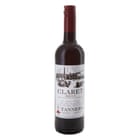When I first started drinking alcohol rather longer ago than I care to remember, most red wines were around 12-13%. Now, though, it’s hard to find one under 14%, and many are 14.5%, which, given the leeway in labelling in some countries, could easily mean 14.8%. So I had some sympathy with a friend who recently bewailed the fact that he couldn’t find a red he enjoyed at an alcohol level with which he felt comfortable. Oh, and he didn’t much enjoy pinot noir, because he found it too light.
The difficulty I had finding wines to suit him illustrates the problem. A combination of rising temperatures and the international taste for riper, fuller-bodied wines has meant very few hit his sweet spot. English wines and natural wines, say, might, but they don’t come cheap, while bordeaux would once have done, but, with a few exceptions such as the Tanners wine in today’s pick, ABVs have crept up there, too. Supermarket own-label bottlings tend to be more modest, as a general rule, but in the case of cheaper reds, that can often leave them a bit weedy.
Italy is a reasonably good hunting ground, though chianti now tends to be more alcoholic than it used to be, too, so the Tuscan red in today’s pick is a real find, and the same is true of Spanish rioja. New-world wines, meanwhile, are almost invariably higher in alcohol, the Trapiche cabernet below being a notable exception.
So what’s my friend to do? One suggestion I made to him – and it may be one of the easiest to implement – was that he should add a judicious amount of water to his glass, rather as you would a whisky: 10% of a 175ml glass of 14.5% red (ie, just over a tablespoon) would bring down the alcohol to 13.18%, while 15%, or just under two tablespoons, would make it 12.61%. Add it gradually, as with whisky, until it’s to your taste. I do much the same with coffee these days, because I find espresso too strong and americano too weak (I just ask for some hot water on the side).
Part of the problem may be that higher alcohol comes hand in hand with ripeness and sweetness, so another suggestion, which came from a wine writer friend on Twitter, would be to dilute leaner wines with a splash of Coke Zero and turn the drink into a calimocho. Shocked? Well, I obviously wouldn’t do that with a fine wine, but why not if you’re trying to moderate your drinking and it makes the wine more to your taste. Just think of it as a cocktail.
Four reds under 14%
Trapiche Reserve Cabernet Sauvignon 2021 £7 Tesco, 12.5%. It’s unusual to find an Argentinian red at this ABV, or this price, and it’s decent, too.

Poggio Badiola Toscana 2019 £11 selected Co-ops, 13%. I love this elegant, supple, Tuscan red. Amazing value, too.

Taste the Difference Discovery Collection Mencia 2019 £11 Sainsbury’s, 13.5%. If you like beaujolais, you’ll love mencia, a similarly bright, juicy red from northern Spain.

Tanners Claret £9.95 (also available in half-bottles and magnums), 13.5%. Absolutely classic, pukka bordeaux claret. Made for a Sunday roast.

Moillard-Thomas Coteaux Bourguignons Rouge 2021 £11.99 (or £9.99 on mix-six) Majestic, 12%. Posh-looking, smart-tasting burgundy, but it’s gamay, not pinot noir. Perfect with a pâté or terrine.


Be the first to comment